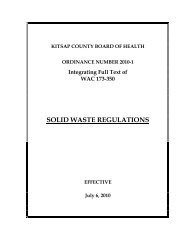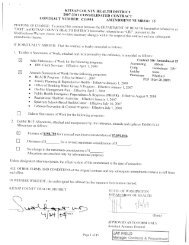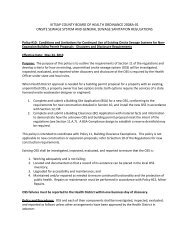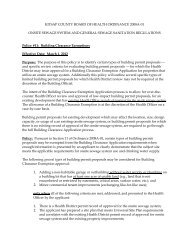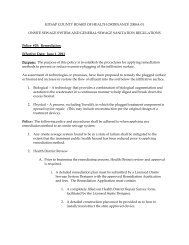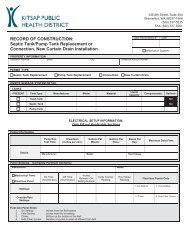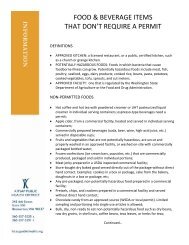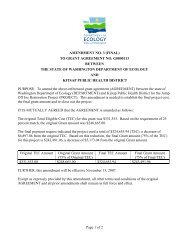Kitsap County Board of Health Ordinance 2008A-01 - Kitsap Public ...
Kitsap County Board of Health Ordinance 2008A-01 - Kitsap Public ...
Kitsap County Board of Health Ordinance 2008A-01 - Kitsap Public ...
You also want an ePaper? Increase the reach of your titles
YUMPU automatically turns print PDFs into web optimized ePapers that Google loves.
<strong>Kitsap</strong> <strong>County</strong> <strong>Board</strong> <strong>of</strong> <strong>Health</strong> <strong>Ordinance</strong> <strong>2008A</strong>-<strong>01</strong>, Amended June 7, 2<strong>01</strong>1<br />
Onsite Sewage System and General Sewage Sanitation Regulations<br />
Soil Type Designation<br />
Table 2<br />
Soil Type Designations and Descriptions<br />
Soil Type Description<br />
Gravelly and very gravelly coarse sands, all extremely gravelly soils<br />
1<br />
excluding Soil Types 5 and 6, all soil types with greater than or equal to 90%<br />
rock fragments<br />
2 Coarse Sands<br />
3 Medium sands, loamy coarse sands, loamy medium sands<br />
4 Fine sands, loamy fine sands, sandy loams, loams<br />
Very fine sands, loamy very fine sands; OR silt loams, sandy clay loams, clay<br />
5<br />
loams, clay loams and silty clam loams with a moderate or strong structure<br />
(excluding platy structure)<br />
6 Other silt loams, sandy clay loams, clay loams, silty clay loams<br />
Sandy clay, clay, silty clay, strongly cemented or firm soils, soil with a<br />
moderate or strong platy structure, any soil with a massive structure, any soil<br />
7<br />
with appreciable amounts <strong>of</strong> expanding clays - Unsuitable for effluent<br />
dispersal and soil dispersal components<br />
2. The owner or designer shall fill the soil log excavations with the removed<br />
soils upon completion <strong>of</strong> inspection by the <strong>Health</strong> Officer.<br />
3. In order to determine or ensure compliance with these regulations, the<br />
<strong>Health</strong> Officer may:<br />
a) Require a wet season evaluation (See “Wet Season Evaluation Procedure”<br />
in Appendix B) and/or additional site inspections <strong>of</strong> the proposed soil<br />
dispersal component area.<br />
b) Require additional soil log excavations, evaluations and/or site<br />
inspections as needed to determine compliance with these regulations<br />
c) Require a stake-out and field marking <strong>of</strong> the location, size, and<br />
configuration <strong>of</strong> the proposed dispersal component on the proposed site.<br />
d) Reduce the required number <strong>of</strong> soil log excavations for a proposed site<br />
development if adequate information already exists, or has previously<br />
been developed and is on file with the <strong>Health</strong> District.<br />
e) Require inclusion <strong>of</strong> a water interceptor as part <strong>of</strong> the design in order to<br />
maintain the minimum vertical separation for the designer-specified<br />
treatment level proposed.<br />
E. Determination <strong>of</strong> Minimum Sewage Treatment and Effluent Distribution<br />
Requirements.<br />
1. The designer shall use Table 3, Minimum Treatment Performance Levels<br />
and Method <strong>of</strong> Distribution, to identify the treatment performance level,<br />
and method <strong>of</strong> effluent distribution for the soil dispersal component,<br />
- 31 -



